Themed collection Most popular organic chemistry articles

Recent advances of 1,2,3,5-tetrakis(carbazol-9-yl)-4,6-dicyanobenzene (4CzIPN) in photocatalytic transformations
In this review, the recent advances of the application of 1,2,3,5-tetrakis(carbazol-9-yl)-4,6-dicyanobenzene (4CzIPN) as a photoredox catalyst in the past three years (2016–2018) for various organic reactions are summarized.

Chem. Commun., 2019,55, 5408-5419
https://doi.org/10.1039/C9CC01047E
Recent advances in sulfonylation reactions using potassium/sodium metabisulfite
Recently, sulfonylation reactions using potassium/sodium metabisulfite as the sulfur dioxide surrogate have been developed rapidly. In most cases, the transformations go through radical processes with the insertion of sulfur dioxide under mild conditions. Additionally, transition metal catalysis is applied in the reactions for the synthesis of sulfonyl-containing compounds.

Chem. Commun., 2020,56, 4145-4155
https://doi.org/10.1039/D0CC01775B
Gold and hypervalent iodine(III): liaisons over a decade for electrophilic functional group transfer reactions
Building on mechanistic perspective, the review intends to demonstrate how the uniqueness of Au-catalysts has realized a myriad of electrophilic functional group transfer reactions with the use of hypervalent iodine(III) reagents over the last decade.
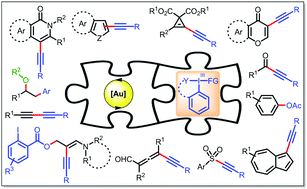
Chem. Commun., 2020,56, 2677-2690
https://doi.org/10.1039/D0CC00106F
Recent advances in phosphine catalysis involving γ-substituted allenoates
This feature article will describe the selected examples of organophosphine catalysis of γ-substituent allenoates with a wide range of electrophiles to give diverse annulations.
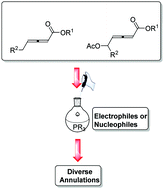
Chem. Commun., 2020,56, 680-694
https://doi.org/10.1039/C9CC08241G
Photoinduced deaminative strategies: Katritzky salts as alkyl radical precursors
Primary amines are one of the most predominant functional groups found in organic molecules. This review covers the most recent developments on photocatalytic deaminative strategies by using Katritzky Salts as alkyl radical reservoirs.

Chem. Commun., 2020,56, 503-514
https://doi.org/10.1039/C9CC08348K
Stereochemical diversity in pyrrolidine synthesis by catalytic asymmetric 1,3-dipolar cycloaddition of azomethine ylides
The aim of this feature article is to show the stereochemical versatility of the metal-catalyzed asymmetric 1,3-dipolar cycloaddition of azomethine ylides.

Chem. Commun., 2019,55, 11979-11991
https://doi.org/10.1039/C9CC05238K
Recent advances in alkoxy radical-promoted C–C and C–H bond functionalization starting from free alcohols
This feature article summarizes our recent achievements in alkoxy radical-promoted C–C and C–H bond functionalization starting from free alcohols.

Chem. Commun., 2019,55, 9747-9756
https://doi.org/10.1039/C9CC04785A
Recent advances in the synthesis of axially chiral biaryls via transition metal-catalysed asymmetric C–H functionalization
Recent advances in the synthesis of axially chiral biaryls via transition metal-catalysed asymmetric C–H functionalization are reported.
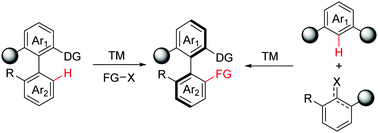
Chem. Commun., 2019,55, 8514-8523
https://doi.org/10.1039/C9CC03967H
Proton-coupled multi-electron transfer and its relevance for artificial photosynthesis and photoredox catalysis
Photoinduced PCET meets catalysis, and the accumulation of multiple redox equivalents is of key importance.
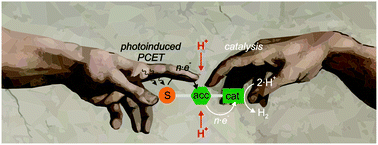
Chem. Commun., 2019,55, 4004-4014
https://doi.org/10.1039/C9CC00821G
Visible-light-mediated arylation of ortho-hydroxyarylenaminones: direct access to isoflavones
The first visible-light-promoted direct synthesis of isoflavones following the arylation of ortho-hydroxyarylenaminones by aryl onium salts was developed.
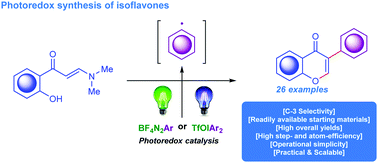
Chem. Commun., 2020,56, 2606-2609
https://doi.org/10.1039/C9CC09945J
Photocatalytic decarboxylative alkenylation of α-amino and α-hydroxy acid-derived redox active esters by NaI/PPh3 catalysis
Herein, we report the photocatalytic decarboxylative alkenylation reactions of N-(acyloxy)phthalimide derived from α-amino and α-hydroxy acids with 1,1-diarylethene, and with cinnamic acid derivatives through double decarboxylation, using NaI and PPh3 as redox catalysts.

Chem. Commun., 2020,56, 2495-2498
https://doi.org/10.1039/C9CC09654J
A general and green fluoroalkylation reaction promoted via noncovalent interactions between acetone and fluoroalkyl iodides
The first example of visible light promoted fluoroalkylation reactions initiated via noncovalent interactions between solvents and RFI is presented.

Chem. Commun., 2020,56, 1815-1818
https://doi.org/10.1039/C9CC09517A
Regioselective synthesis of 4-fluoro-1,5-disubstituted-1,2,3-triazoles from synthetic surrogates of α-fluoroalkynes
This TFA-catalyzed [3+2] cycloaddition of organic azides with α-fluoronitroalkenes, used as synthetic surrogates of α-fluoroalkynes, provides a new route to multi-substituted fluorotriazoles with broader substrate scopes and high regioselectivity.
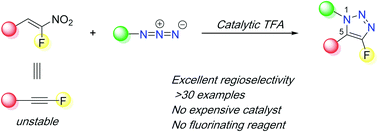
Chem. Commun., 2020,56, 1871-1874
https://doi.org/10.1039/C9CC09216A
Metal-free sulfonyl radical-initiated cascade cyclization to access sulfonated indolo[1,2-a]quinolines
A metal-free cascade reaction was developed for the synthesis of indolo[1,2-a]quinoline derivatives from arylsulfonyl hydrazides and 1-(2-(arylethynyl)phenyl)indoles in the presence of TBAI/TBHP.
![Graphical abstract: Metal-free sulfonyl radical-initiated cascade cyclization to access sulfonated indolo[1,2-a]quinolines](/en/Image/Get?imageInfo.ImageType=GA&imageInfo.ImageIdentifier.ManuscriptID=C9CC06924K&imageInfo.ImageIdentifier.Year=2019)
Chem. Commun., 2019,55, 12615-12618
https://doi.org/10.1039/C9CC06924K
Photoinduced synthesis of fluorinated dibenz[b,e]azepines via radical triggered cyclization
A simple, mild and efficient approach to access fluorinated dibenz[b,e]azepines via visible-light photoredox catalysis is presented.
![Graphical abstract: Photoinduced synthesis of fluorinated dibenz[b,e]azepines via radical triggered cyclization](/en/Image/Get?imageInfo.ImageType=GA&imageInfo.ImageIdentifier.ManuscriptID=C9CC04977K&imageInfo.ImageIdentifier.Year=2019)
Chem. Commun., 2019,55, 10848-10851
https://doi.org/10.1039/C9CC04977K
Pd/NHC-catalyzed cross-coupling reactions of nitroarenes
N-Heterocyclic carbene (NHC) ligands effective for the cross-coupling of nitroarenes were identified.
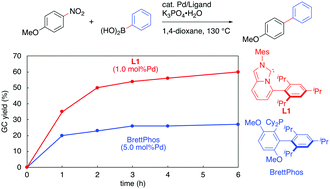
Chem. Commun., 2019,55, 9291-9294
https://doi.org/10.1039/C9CC05055H
Intramolecular palladium(II)/(IV) catalysed C(sp3)–H arylation of tertiary aldehydes using a transient imine directing group
Indane-aldehydes are formed using palladium catalysis and a transient directing group to promote intramolecular C–H functionalisation with aryl bromides.
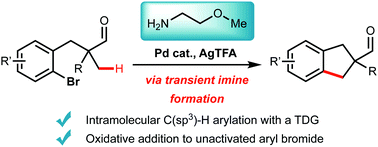
Chem. Commun., 2019,55, 9172-9175
https://doi.org/10.1039/C9CC03644J
Transition-metal- and oxidant-free directed anodic C–H sulfonylation of N,N-disubstituted anilines with sulfinates
A new, practical directed anodic C–H sulfonylation of N,N-disubstituted anilines with sodium sulfinates for producing o- or p-amino arylsulfones and diarylsulfones is described.

Chem. Commun., 2019,55, 8995-8998
https://doi.org/10.1039/C9CC03789F
Straightforward chemo- and stereoselective fluorocyclopropanation of allylic alcohols: exploiting the electrophilic nature of the not so elusive fluoroiodomethyllithium
The not so elusive carbenoid fluoroiodomethyllithium disclosed its electrophilic nature in an unprecedented direct and stereoselective fluorocyclopropanation of allylic alcohols.

Chem. Commun., 2019,55, 8430-8433
https://doi.org/10.1039/C9CC03394G
Gold redox catalysis for cyclization/arylation of allylic oximes: synthesis of isoxazoline derivatives
Base-assisted diazonium activation has been employed to promote gold(I)/(III) redox catalysis toward allylic oxime cyclization/aryl coupling.
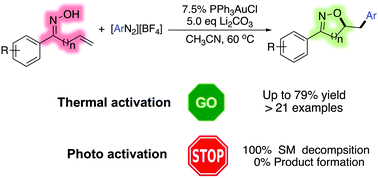
Chem. Commun., 2019,55, 8150-8153
https://doi.org/10.1039/C9CC02830G
Nickel-catalysed dehydrogenative coupling of aromatic diamines with alcohols: selective synthesis of substituted benzimidazoles and quinoxalines
The nickel-catalysed dehydrogenative coupling of 1,2-di-amino-benzene with primary alcohols and diols for the synthesis of N-heterocycles is reported. The catalytic protocol enables the transformation in up to 91% yield and generates water and hydrogen gas as byproducts.

Chem. Commun., 2019,55, 5958-5961
https://doi.org/10.1039/C9CC02319D
Direct biocatalysed synthesis of first sulfur-, selenium- and tellurium- containing L-ascorbyl hybrid derivatives with radical trapping and GPx-like properties
6-O-L-Ascorbyl selenoesters, thioesters and telluroesters can be efficiently and directly prepared from L-ascorbic acid and suitable functionalised chalcogenoesters through lipase-catalysed transesterification reactions.

Chem. Commun., 2019,55, 5705-5708
https://doi.org/10.1039/C9CC02427A
A ‘sulfonyl-azide-free’ (SAFE) aqueous-phase diazo transfer reaction for parallel and diversity-oriented synthesis
Diazo transfer reactions are notoriously associated with the use of potentially explosive sulfonyl azides. Handling of the latter can be avoided with the use of this new protocol.
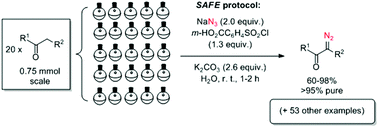
Chem. Commun., 2019,55, 5239-5242
https://doi.org/10.1039/C9CC02042J
Visible light mediated, metal-free carbene transfer reactions of diazoalkanes with propargylic alcohols
The photolysis of donor–acceptor diazoalkanes in the presence of propargylic alcohols furnishes valuable, sterically demanding tetra-substituted cyclopropenes in high yield under metal-free conditions.

Chem. Commun., 2019,55, 4881-4884
https://doi.org/10.1039/C9CC00927B
Trifluoromethylthiolative 1,2-difunctionalization of alkenes with diselenides and AgSCF3
An efficient regioselective difunctionalization of alkenes via trifluoromethylthiolation has been accomplished employing diaryl diselenide and AgSCF3 in the presence of BF3·OEt2.

Chem. Commun., 2019,55, 4639-4642
https://doi.org/10.1039/C9CC00815B
Iodine–DMSO-promoted divergent reactivities of arylacetylenes
An unprecedented set of efficient, economical, atom-economic and exceedingly selective I2–DMSO-promoted methods is described for the generation of different structures.

Chem. Commun., 2019,55, 4511-4514
https://doi.org/10.1039/C9CC00346K
Exogenous-oxidant-free electrochemical oxidative C–H phosphonylation with hydrogen evolution
We herein report a versatile and environmentally friendly electrochemical oxidative C–H phosphonylation protocol.
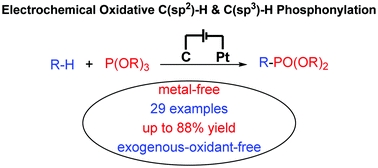
Chem. Commun., 2019,55, 4230-4233
https://doi.org/10.1039/C9CC00975B
Synthesis of indoles and quinazolines via additive-controlled selective C–H activation/annulation of N-arylamidines and sulfoxonium ylides
Selective synthesis of indoles and quinazolines was achieved through a precise control of C–H activation/annulation by changing additives.

Chem. Commun., 2019,55, 4039-4042
https://doi.org/10.1039/C9CC01146C
Regioselective synthesis of polycyclic sulfones via radical-induced three-component bicyclization cascades
New radical-triggered three-component bicyclization cascades of 2-alkynylaryldiazonium tetrafluoroborates with a sulfur dioxide surrogate DABCO·(SO2)2 and internal alkynes have been reported for the first time, leading to 49 examples of polycyclic sulfones with moderate to good yields.

Chem. Commun., 2019,55, 3227-3230
https://doi.org/10.1039/C9CC00324J
Laser synthesis of oxygen vacancy-modified CoOOH for highly efficient oxygen evolution
Laser ablation in liquids has been, for the first time, employed to produce oxygen vacancy-modified CoOOH nanosheets for efficient water oxidation.
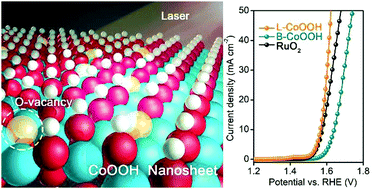
Chem. Commun., 2019,55, 2904-2907
https://doi.org/10.1039/C8CC08951E
Silver-catalyzed decarboxylative radical cascade cyclization toward benzimidazo[2,1-a]isoquinolin-6(5H)-ones
A decarboxylative radical addition/cyclization strategy was developed, by which a wide range of benzimidazo[2,1-a]isoquinoline-6(5H)-ones were prepared via reaction of 2-arylbenzoimidazoles and carboxylic acids.
![Graphical abstract: Silver-catalyzed decarboxylative radical cascade cyclization toward benzimidazo[2,1-a]isoquinolin-6(5H)-ones](/en/Image/Get?imageInfo.ImageType=GA&imageInfo.ImageIdentifier.ManuscriptID=C8CC10243K&imageInfo.ImageIdentifier.Year=2019)
Chem. Commun., 2019,55, 2861-2864
https://doi.org/10.1039/C8CC10243K
Thiourea dioxide as a source of sulfonyl groups: photoredox generation of sulfones and sulfonamides from heteroaryl/aryl halides
Thiourea dioxide is applied as the source of sulfonyl groups for the efficient synthesis of heteroaryl sulfones and sulfonamides from heteroaryl halides under visible light irradiation. This transformation proceeds through a radical process via heteroaryl sulfinate intermediates, as supported by EPR spectroscopy and DFT calculations.

Chem. Commun., 2019,55, 2489-2492
https://doi.org/10.1039/C9CC00008A
Photoredox-catalyzed sulfonylation of alkyl iodides, sulfur dioxide, and electron-deficient alkenes
A photoredox-catalyzed sulfonylation of alkyl iodides, sulfur dioxide, and electron-deficient alkenes under mild conditions is achieved. Various functional groups including nitro, halo, acetyl, sufonyl, and pyridinyl are all tolerated under the photoredox conditions.

Chem. Commun., 2019,55, 2214-2217
https://doi.org/10.1039/C9CC00347A
Electrochemical oxidative C–H/N–H cross-coupling for C–N bond formation with hydrogen evolution
We herein report an electrochemical oxidative C–H/N–H cross-coupling reaction in an undivided cell.
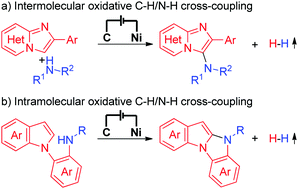
Chem. Commun., 2019,55, 1809-1812
https://doi.org/10.1039/C8CC09899A
Thiourea participation in [3+2] cycloaddition with donor–acceptor cyclopropanes: a domino process to 2-amino-dihydrothiophenes
The Yb(OTf)3 catalyzed [3+2] cycloaddition of donor–acceptor cyclopropanes with thiourea offers an efficient route to diverse 2-amino-4,5-dihydrothiophenes.
![Graphical abstract: Thiourea participation in [3+2] cycloaddition with donor–acceptor cyclopropanes: a domino process to 2-amino-dihydrothiophenes](/en/Image/Get?imageInfo.ImageType=GA&imageInfo.ImageIdentifier.ManuscriptID=C8CC09595G&imageInfo.ImageIdentifier.Year=2019)
Chem. Commun., 2019,55, 1580-1583
https://doi.org/10.1039/C8CC09595G
About this collection
This specially curated collection pulls together some of the most popular recent ChemComm articles in the field of organic chemistry. The collection presents some outstanding contributions to the field, with research ranging from electrochemical cross-coupling reactions to asymmetric C‒H functionalization reactions. We hope you enjoy browsing through this collection.